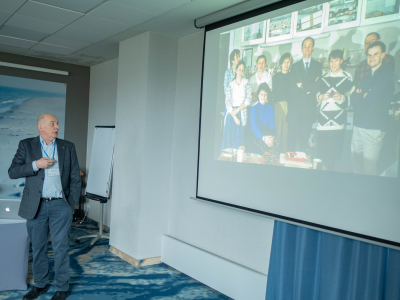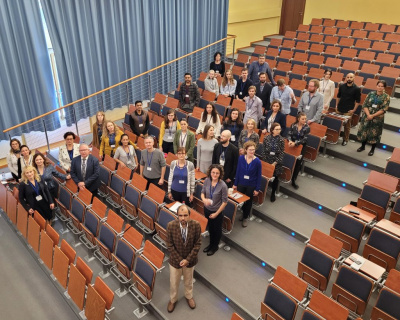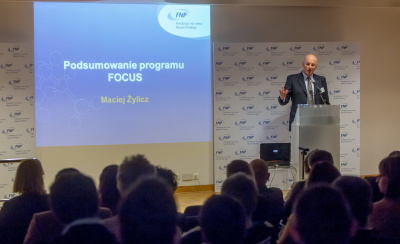Distinguished molecular biologist prof. dr hab. Maciej Żylicz, President of the Foundation for Polish Science, talks about setting up his team of scientists when 'there was no money for practically anything', the current state of Polish biotechnology and working on his most important publications. We invite you to read the interview.
Marcel Jakubowski: - In the 1980s, you returned to Poland richer in the experience of working with foreign scientists and with a grant from the National Institute of Health. Which of these benefits was more valuable in your later scientific work and running a successful laboratory?

Prof. Maciej Żylicz talking about his team during the conference 'J-domain proteins from molecular mechanisms to diseases' organised, among others, by the Inter-University Faculty of Biotechnology of the UG and MUG
Prof. dr hab. Maciej Żylicz: - We received the grant from the NIH together with prof. Costa Georgopoulos from Utah University, with whom I worked for several years in the US. It was a reward for the outstanding settlement of a previous grant - the NIH Merit Award. Through the Max Planck Institute in Berlin, it was possible to use some of this money to fund research by the new scientific team I was setting up in Gdańsk. That was 1985, a time when there was no money for practically anything in Polish scientific institutions, so this was precious financial help. Cooperation with foreign countries was also extremely important. But the most important thing was to convince a group of talented young people, Krzysztof Liberk, Dorota Skowyra, Jurek Osiupiuk and Bogdan Banecki, to take a risk and start researching their PhDs under my guidance. For these young people, not yet familiar with the scientific environment, it was a tough decision - to start working on a doctorate under a guy who had not even been habilitated (I received my habilitation degree in 1986). Later, PhDs Jarosław Marszałek, Igor Konieczny and Alicja Wawrzynów joined our team. Two of these original team members emigrated to the USA and are working scientifically there; the others are titular professors in Gdańsk or Warsaw today. Later, other doctoral students joined our team, led by me and the young postdoctoral fellows Krzysztof Liberek, Jarosław Marszałek, Igor Konieczny and Alicja Wawrzynów.
- Among other things, you showed that heat shock proteins and the MDM2 oncogene have chaperone protein activity or discovered that the tumour suppressor protein, p53, requires chaperone proteins for its activity. In retrospect, which discovery of your team was the most important?
- I think the most outstanding achievement of my first 20 years at the University of Gdańsk was discovering that the bacterial heat shock proteins I described: DnaK, DnaJ, and GrpE, have chaperone protein activity. This was successfully demonstrated for both the initiation of viral DNA replication, the dissociation of aggregates of the enzyme responsible for RNA synthesis and proteins involved in degradation. I spent the next 20 years of my scientific career (after 1999) at the International Institute of Molecular and Cell Biology in Warsaw. In the new scientific team, together with my wife Alicja Żylicz, we promoted 15 PhD students. We showed that selected human heat shock proteins are essential for activating p53 - a tumour suppressor protein. Interestingly, the same heat shock proteins cause altered p53 protein (mutation in the TP53 gene) to stimulate tumour formation. One recent paper by our team shows that by looking at the levels of selected heat shock proteins, it is possible to predict how a breast cancer patient will respond to chemotherapy, i.e. whether, after a certain period of time, her body will induce resistance to this chemotherapeutic agent. It is very satisfying when our basic research on tumour formation has clinical implications.
- Taken together, this amounts to almost 8,000 citations in the world literature or an average of 85 per publication. That sounds very impressive. How did you select the subjects of your experiments?
- Parameters such as the number of papers, the total citations of all papers, the Hirsh factor or the so-called impact factor of the journal in which the paper was published do not necessarily indicate that a significant scientific discovery has been made. The citation level of individual scientific papers gives us some information on this. I have 25 experimental papers in my scientific output, each of which is cited more than 100 times. This, in the field of molecular biology, means that the scientific community has recognised these papers as important, original and wants to cite them. I rarely publish (in 40 years, I have only published 90 papers); I only do so when I have as complete an answer as possible to scientifically essential questions. Sometimes, a whole team has worked on a single issue for several years. Unfortunately, there have also been times when our efforts have been in vain, and we have yet to be able to find answers to our questions, and there has been no publication in this area. This is also part of scientific work. The questions I posed or my colleagues posed (we discussed our results together) had to be not only important and original but also ones that could be dealt with by the technology available at the time.

International Centre for Cancer Vaccine Science
- One of the more high-profile achievements of the International Centre for Cancer Vaccine Research (funded by FNP) was the discovery that elephants have as many as 20 TP53-type genes that produce copies of the p53 protein. This is just one of many discoveries in molecular biology in Poland. How do you assess the development of this field in Poland since the transition period?
- Indeed, I read with great interest a paper published in 2022 with the collaboration of researchers from the International Centre for Cancer Vaccine Research at the University of Gdańsk (a centre funded by the FNP MAB programme), whose first author is Monikaben Padariya. As it turns out, elephants have 20 almost identical genes encoding the p53 protein, the expression of which inhibits tumorigenesis. Moreover, very interestingly, the study showed that these proteins are not degraded with the MDM2 gene (in humans, the p53 protein is degraded in an MDM2-dependent reaction), which is an original scientific finding. Presumably, the lack of p53 degradation and the activation of a new copy of the gene encoding p53 (when mutations in another gene encoding the p53 protein are present) is why elephants rarely develop cancer. Answering why MDM2 does not affect p53 degradation in elephants may help develop new anti-cancer drugs. Biotechnology, which deals, among other things, with creating new drugs for many diseases, including cancer, is developing very well in Poland. I am currently observing this as President of the Foundation for Polish Science. We run Poland's oldest scholarship programme, START, which rewards young scientists in all fields for original scientific achievements. At the beginning of the programme (the first competition was held in 1993), to win a grant (100 or more were awarded yearly) in molecular biology/biotechnology, it was enough to have one good experimental paper. Now, 30 years later, it is not enough. You have to be the author of a groundbreaking paper recognised by other specialists working in the field. The level of work in molecular biology/biotechnology has clearly improved, and I am very happy about that.

Prof. Maciej Żylicz at the conference of FOCUS programme laureates and scholarship holders, source FNP
- During the transition period, you created your own research team, which has been very successful internationally. Now, as part of the Foundation for Polish Science, you are helping other scientists to do the same. Which teams does the FNP want to subsidise?
- Since the beginning of my work at the FNP, which was already 18 years ago, supporting young researchers in achieving scientific independence has become one of the strategic goals of our activities, and it has remained so to this day. In the new financial perspective of the EU, i.e. under the FENG 2021-2027 programme, we are planning to launch support programmes for outstanding researchers in several key areas, including the continuation of the FIRST TEAM programme (aimed at researchers up to 12 years after their PhD whose research plans have the potential to obtain an ERC grant). In addition, as early as May this year, we intend to launch the first competitions under the MAB programme - for the creation (and in some cases, the development of already existing) centres of scientific excellence working on scientific discoveries that change the rules of the game in a given scientific field. The commercialisation of such scientific achievements can lead to an advantage in the global market. Another programme, TEAM-NET, is to help create consortia of research units where the basic research phase has been completed. There is a good chance to commercialise the scientific results they have obtained. We also plan to fund PoC (Proof of Concept) grants, which will facilitate researchers at universities and research institutes to verify the commercialisation potential of the scientific results they have obtained from basic research. Finally, we plan to launch the most difficult to implement programme, PRIME, designed to create spin-offs, companies based on scientific discoveries made in these environments, around Polish universities and research institutes. The programme is based on the experience of the British cities of Oxford and Cambridge. Thousands of companies have been created that successfully exploit the scientific achievements made at Oxford and Cambridge Universities.
- Thank you for the interview.
- Thank you.
Read more about the initiatives and programmes of the Foundation for Polish Science.
